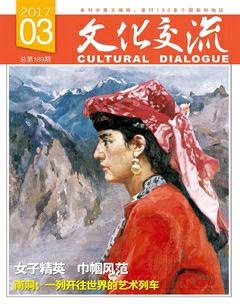南洞:一列開往世界的藝術列車
季長弓
“功勛號”火車是南洞藝谷的標志性景點。經過改造,車廂內依次設立了特色音樂火車餐廳、火車影院、“火車青旅”、小點音樂藝術臺直播間等別具一格的設施。這列長長的綠皮火車仿佛是一列開往世界的藝術列車。
“這里是一個天然大氧吧,是‘美麗經濟,印證了綠水青山就是金山銀山的重要理論。下次來了,咱就住這里!”2015年5月25日,習近平總書記在舟山市定海區新建社區考察調研時,對南洞藝谷作了高度評價。總書記的贊譽,讓南洞藝谷美名遠揚。
2016年10月26日,30余位來自海內外的媒體記者走進坐落在舟山定海的干鎮新建社區即南洞藝谷。南洞藝谷占地面積達2平方公里,這里擁有美好的自然生態環境、濃郁的文化藝術氣息。經過近6年的打造,如今,它就像一顆撒落在東海洋面熠熠閃光的明珠。
充滿詩情畫意的美術樂園
南洞藝谷家家戶戶的外墻,是一幅幅彩繪壁畫,色彩斑斕,形象生動。這些壁畫色彩風格各不相同,有古色古香的傳統中國畫“嫦娥奔月”,也有滿是英文的美式涂鴉;有充滿中國古典特色的戲劇臉譜,也有生動活潑的卡通形象……充滿創意的壁畫使這些村舍頓時靈動起來。
穿行在南洞的民居小巷,就像走進了一片藝術長廊。復古修建的明清老街同是徽派風格,古樸的廊橋、靜謐的宅院,與青山綠水渾然天成。
來到南洞藝谷,“群島美術館”是不得不去的地方,這是舟山市首個村級海島美術館。
群島美術館館長張高俊介紹,美術館建筑面積500平方米左右,擁有書畫院、展示廳和會議室等,免費向公眾開放。舟山漁民畫是從上個世紀80年代發展起來的中國現代民間繪畫之一。作者絕大部分是漁家兒女,作品反映的也都是漁民日常勞動、生活場景和海洋漁區所特有的海邊風俗、民間傳說等,注重地域特色。
這些個性強烈的藝術作品因具有原汁原味的大海情感、無拘無束的變化手法、無法意料的形式美感,透露出一種特殊的表現力和吸引力。
走進美術館,柔光映照著大量的美術作品,海洋浮雕、舟山漆盤、船木家具、漁民畫等等,令人目不暇接。扎蟹、曬魚鲞、補漁網、看大戲……一幅幅帶有“海味”的漁民畫映入眼簾。
張高俊是舟山漁民畫產業協會會長,已經為當地村民陸續辦了7期培訓班,數十人跟著他學會了版畫、剪紙等手藝,年齡最大的已經有70多歲。
群眾藝術創作中心展覽著近百件由當地村民創作的工藝美術作品。看了一件件充滿生活氣息的畫作和手工藝品,習近平總書記連聲稱贊正在繪畫的村民和藝校學生心靈手巧,稱贊指導老師做了一件有意義的事。他說,舟山漁民畫很有特色,很有味道。這里氛圍很好,為家鄉培養了人才。
習總書記調研新建社區時,正值浙江職業藝術學院學生在此寫生,他們高興地將自己的畫作贈送給總書記。
底蘊深厚的舟山海洋文化孕育著優秀的本土藝術,充滿生機與活力的海島為漁民畫作者提供了廣闊的創作舞臺。
南洞戲劇谷春色如許
如今,“南洞藝谷”又添一個響亮的名號——“中國南洞·戲劇谷”。
聽聞村里要辦“戲劇谷”,78歲的袁阿婆很是高興,“有戲文看,老百姓當然開心!”而“戲劇谷”的打造,又何止“戲文”?戲劇舞臺改造、戲劇廣場建設、戲劇景觀街打造,這些全新的項目已經提上日程,將在今年年底前全部建成。南洞還將引進知名戲劇文藝團隊、戲劇名家工作室,組織戲劇演出,建設中國戲劇原創實驗基地。目前,已組建了三支戲劇團隊,開展文化傳承、戲劇培訓、演出等活動。
2011年,幽蘭吐蕊,全國戲劇名家聚會南洞獻智獻策,“南洞戲劇谷”風生水起。
新建社區在新農村建設中打破傳統思維和模式,規劃全國藝術院校大學生實習采風基地,他們改造部隊舊營房,配套建設了一次性可容納600人居住的學生宿舍。2011年4月9日,南洞的全國藝術院校大學生實習采風基地與中國美院、浙江藝術職業學院、華僑大學等26所院校建立緊密合作關系。如今,“中國南洞·戲劇谷”年均接待藝校學生達到3萬余人次。
在定海南洞藝谷的水庫大壩上,經常能看見一群漂亮的女孩在綠水青山的環抱中,開嗓練聲、訓練形體。“南洞真的很美,在這里排練,嗓子放得開,經老師指導一點就通。”一名叫陳杉杉的學生說,她們來自浙江藝術職業學院戲劇系,來這里主要是排練畢業作品——越劇《五女拜壽》。
2016年5月23日,新建社區重要的文化地標——文化禮堂建成開放,一樓就是戲劇展陳館,陳列著色彩鮮亮、形態各異的戲劇臉譜和古色古香的二胡、小鼓、的篤板等樂器……通過精美戲服、演出道具等陳列展示,弘揚中國傳統戲劇文化。
一位來自法國華文報的記者說:“這里是一個戲劇的藝谷,也是舟山地方戲曲的展示基地。”她指著展廳中舟山木偶戲的圖照饒有興味地說道。
舟山的布袋木偶戲,傳說是從寧波傳入,吸收本地的土語、民間小調、地方戲曲等成分,逐漸形成獨有的海島風格,2009年被列入第三批省級非物質文化遺產保護名錄。
“中國南洞·戲劇谷”,在新建生態村多彩的文化畫卷添上濃墨重彩的一筆。
當阿拉伯藝術家邂逅藝谷的海洋文化
除了戲劇,還有音樂、攝影、刺繡、太極功夫,多種藝術門類在這里相輔相成,相映生輝。
小點音樂工場猶如高山流水,琴瑟合鳴。該音樂工場由王飛躍創辦,是集詞曲創作、音樂制作、企業歌曲定制、音樂藝術培訓、專業錄音棚錄音、演藝音樂活動策劃于一體的專業音樂機構。
走進劉彩素手工藝工作室,只見飛針走線,巧奪天工。她的絨線繡,又叫絨繡、毛線繡,是用彩色毛線在特制的網眼麻布上進行繡制的手工藝品。絨線繡起源于法國,18世紀開始流行于歐洲,并為歐洲王室所推崇。
劉彩素今年60歲,是干鎮青龍社區村民,愛好看書、種花,年輕時就是遠近聞名的繡花能手,現在負責姐妹繡花加工廠。這個繡花廠名聲在外。劉彩素在繡花、釘珠等手工藝制作方面技術精湛,還主持幼兒刺繡教學和成人絨繡制作工藝培訓。在浙江省婦女手工藝產品創意大賽中,由該鎮婦聯選送的絨繡作品《春華秋實》獲得三等獎。該作品做工精細,是純羊毛線手工繡制,采用傳統的絨繡針法,經過十余天繡成。作品正中是一朵國色天香的牡丹,花開正艷,春意盎然,表達了作者對美好生活的向往和贊譽。
當阿拉伯藝術家遇見舟山海洋文化,會擦出怎樣的火花?
參加第五屆“意會中國”訪華采風暨海上絲綢之路舟山行活動的阿拉伯知名藝術家們,來到定海南洞藝谷。這兒無處不在的濃郁海洋文化藝術氣息、有著民間畫圖案的枕套杯墊和掛飾、繪有觀音佛像的絲巾,甚至用舊船板制成的桌椅,都讓阿拉伯藝術家愛不釋手。
工作室鋪著的一幅創作中的漆畫作品,成了阿拉伯藝術家們圍觀的對象。也門藝術家馬茲哈對漆畫的創作工藝和原料非常感興趣,他摸摸畫板上粘著的貝殼片,還用手指捻了點漆屑聞一聞。漆畫是張高俊的絕技,他有兩幅作品入選了第十二屆全國美展。
張高俊捧出一摞《高俊畫集》,贈送給11位來訪的阿拉伯藝術家,68歲的摩洛哥藝術家薩義德也拿出一本個人四十年創作的畫集作為回贈。張高俊眼前一亮,“畫得真不錯,手法特異,風格空靈,值得我們借鑒。”蘇丹藝術家約瑟夫邀請張高俊去蘇丹采風創作一個月。“如果時機合適,當然去。他們是‘海上絲路舟山行,我來一趟‘海上絲路阿拉伯行嘛!”
在舟山本土畫家張高俊爽朗而自豪的笑聲中,人們感悟到各國藝術家之間一旦產生共鳴,便可以跨越種族與語言交流的屏障而融合在一起。
“綠水逶迤去,青山相向開。”南洞藝谷之美,如同一軸流淌著的山水畫卷。習近平總書記到訪南洞藝谷,令世界關注。南洞藝谷正在打造一張國際金名片。
春暖花開時節,全國各地的游客、藝術家乃至國際友人、嘉賓紛紛來到舟山定海南洞藝谷參觀訪問,進行文化交流。他們第一眼看到的就是那列綠皮火車。南洞藝谷這列不同尋常的文藝列車將開出國門,開向世界的遠方!
Island Village Prospers
in Art
By Ji Changgong
Nandong used to be a quiet village on Dinghai, the biggest Island in Zhoushan Archipelago, Zhejiang Province. About six years ago, it began to recreate and redefine itself in art. The effort and ambition have paid off. On May 25, 2015 President Xi Jinping came to visit the village during his inspection tour on the archipelago and admired and praised the scenic beauty of the island village. President Xis appreciation put the village on the map. Tourists and journalists have come in to take a look at the village that is thriving in art.
Nowadays, the village has renamed itself as Nandong Art Valley. The houses displays wall paintings in bright colors and most of these images on the walls can be seen, completely and incompletely, from afar. The murals come in a collage of different styles. Some are traditional images in traditional and folk art styles. Some are graffiti images with English messages. Some are cartoon personalities. Talking a stroll through the village of traditional houses and covered bridges gives one a brief lecture on the architectural styles of the dynasties of the Ming (1368-1644) and the Qing (1644-1911) that have survived on the island.
Archipelago Art Museum is a must for tourists. The 500-square-meter structure gives visitors an insight into the local folk art, known as fishermens painting, which germinated in the 1980s and has bloomed in the archipelago since then. The nearly 100 paintings on display inside the museum are very different from the wall paintings outside. All the paintings are created by villagers, reflecting the island lifestyle, everyday activities, customs, faith, folklore and legends. Unexpected, unbridled, and unpretentious, these artworks create a raw appeal in garish colors and raw brushwork.
The artworks are by villagers. Zhang Gaojun, director of fishermen painters association of Zhoushan and curator of Archipelago Art Museum, has held seven training courses in Nandong and dozens of villagers have come in to learn printmaking and paper-cutting. The oldest student is in his 70s.
The art village also attracts art students from outside the archipelago to sketch and prepare their graduation work there. President Xi Jinping on his 2015 visit to Nandong ran into a group of students from Zhejiang Vocational Art Academy sketching there.
Students favor the village for another reason. A nearby military barracks has been remodeled into a huge compound which can accommodate 600 students. In 2011, Nandong struck up strategic partnerships with 26 higher education institutions such as China Academy of Art, Zhejiang Vocational Art Academy, and Overseas Chinese University across the country. Nowadays the village receives 30,000 students a year. As some art schools in China also have theater departments, art students visiting Nandong also include those studying performing arts. With the constant presence of young artists in the village, Nandong has turned itself into a theater sanctuary. In May 2016, the village unveiled a new cultural center, which doubles as a theater museum. On display are facial masks, traditional music instruments used in regional operas, and costumes in various designs and colors. Also on display are hand puppets. The local puppet show originally came from Ningbo, a port city on the mainland across the sea. After the puppet show came to the archipelago, the art absorbed expressions from the dialect, folk tunes on the islands, and island theater performances. Over centuries, the puppet show has grown into its own and features a distinct island style. In 2009, the provincial government put the show on an intangible cultural heritage list for cultural preservation.
Nandong doesnt define art in a narrow sense. Music, photography, embroidery and Chinese shadow boxing have taken their respective footholds there. Xiaodian Music Studio, operated by Wang Yuefei, has a complete professional-class recording system and has space for music and art training. Liu Caisu, an archipelago islander, runs an embroidery workshop in Nandong. The 60-year-old folk art master was a local celebrity of embroidery in her youth years. Now she owns and operates an embroidery plant and hosts a training course. Her embroidery work once won a third award at a provincial competition for women artists.
In addition to the artistic ambiance of the island village, there is a long train parked outside the village. The island itself doesnt have a history of railroad and the train doesnt move and isnt going anywhere. It is just a landmark suggesting the outside world. The train has a long history of honors and now retired to the village on the island. The train cars now respectively serve as a restaurant, a movie house, a hotel, a music radio.

